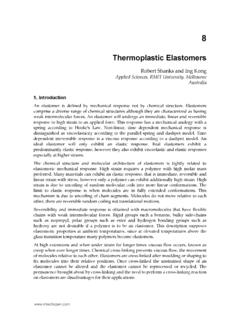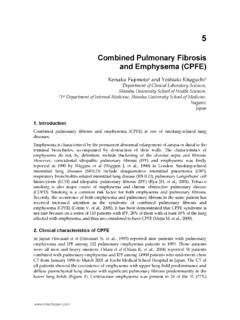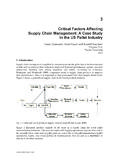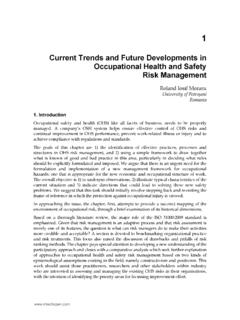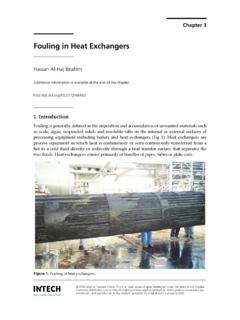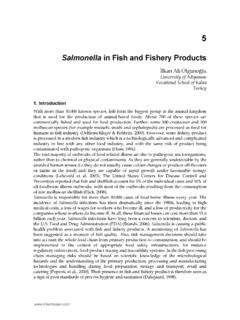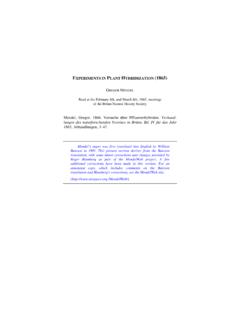Transcription of Characterization and Properties of Chitosan
1 5. Characterization and Properties of Chitosan Elson Santiago de Alvarenga Universidade Federal de Vi osa, Departamento de Qu mica, Vi osa, MG, Brazil 1. Introduction The biopolymer is characterized as either chitin or Chitosan according to the degree of deacetylation (DD) which is determined by the proportion of D-glucosamine and N-acetyl- D-glucosamine. Structurally, Chitosan is a straight-chain copolymer composed of D-glucosamine and N-acetyl-D-glucosamine being obtained by the partial deacetylation of chitin. Chitosan is the most abundant basic biopolymer and is structurally similar to cellulose, which is composed of only one monomer of glucose (Fig.)
2 1). Chitosan solubility, biodegradability, reactivity, and adsorption of many substrates depend on the amount of protonated amino groups in the polymeric chain, therefore on the proportion of acetylated and non-acetylated D-glucosamine units. The amino groups (pKa from to ) are completely protonated in acids with pKa smaller than making Chitosan soluble. Chitosan is insoluble in water, organic solvents and aqueous bases and it is soluble after stirring in acids such as acetic, nitric, hydrochloric, perchloric and phosphoric (Guibal, 2004; Kluget al., 1998; Kubota et al.
3 , 2000; Kurita, 2006; Anthonsen & Smidsroed, 1995; Rinaudo, 2006;. Sankararamakrishnan & Sanghi, 2006). CH3 CH3. OH O. O. NH O NH. HO O HO. O. O HO O. O NH O. O. OH OH. CH3. Chitin CH3. OH O. NH2 O NH. HO O HO. O. O HO O. O NH2 O. OH OH. Chitosan OH. OH O OH. HO O HO. O. O HO O. O OH O. OH OH. Cellulose Fig. 1. Structures of chitin, Chitosan , and cellulose 92 Biotechnology of Biopolymers Food contaminations and the negative environmental impact of packaging materials currently in use have prompted the research of safer materials. Chitosan have shown great promise to be used in food industry as preservative because of its high antimicrobial activity against various microorganisms.
4 The quality of a variety of food products are maintained by Chitosan based films (Dutta et al., 2009). Chitosan is considered one of the most valuable polymer for biomedical and pharmaceutical applications due to its biodegradability, biocompatibility, antimicrobial, non-toxicity, and anti-tumor Properties . Nanoparticles, microspheres, hydrogels, films, and fibers are typical Chitosan based forms for biomedical and pharmaceutical applications. Examples of such applications include nasal, ocular, oral, parenteral and transdermal drug delivery (Kumar, 2000). The science for creating three dimensional body parts by seeding cellular material in vitro on a scaffold, to replace diseased body parts is defined as tissue engineering.
5 The scaffold should be biodegradable and elastic for contractile tissues such as blood vessels and heart valves. It is therefore necessary to develop tissue like matrix with interconnected network, to act as templates to guide cell growth, transfer of nutrients, oxygen and waste products (Kathuria et al., 2009). Cross-linked Chitosan hydrogels as potential tissue engineering scaffold can be prepared by Schiff base reaction between the N-succinyl- Chitosan and the aldehyde group from the oxidized hyaluronic acid. Encapsulation of bovine chondrocytes within the cross-linked hydrogel demonstrated that the composite hydrogel supported cell survival and the cells retained chondrocytic morphology.
6 Hydrogels are attractive candidates for tissue regeneration due to its extracellular matrix mimic structure and the ability to form under mild conditions (Tan et al., 2009). Chitosan microspheres as delivery drug carriers can be prepared by the water-in-oil emulsion solvent diffusion method, being ethyl acetate the oil phase. Figure 2 displays Scanning Electron Microscopy (SEM) image of the Chitosan microspheres with drug entrapment (Phromsopha & Baimark, 2010). Fig. 2. Scanning Electron Microscopy (SEM) of drug-loaded Chitosan microparticles (reproduced from Phromsopha & Baimark, 2010).
7 Chitosan has been largely employed in many areas, such as photography, biotechnology, cosmetics, food processing, biomedical products (artificial skin, wound dressing, contact lens, etc.), system of controlled liberation of medicines (capsules and microcapsules), treatment of industrial effluents for removal of metallic and coloring ions. The amino groups are responsible for the distinct characteristics attributed to this basic polymer (compared to an acidic biopolymer). Therefore, the Characterization of the polymer in either chitin or Characterization and Properties of Chitosan 93.
8 Chitosan is extremely important according to the structure- Properties relationship, defining a possible industrial application. Thus many techniques are available to determine the degree of deacetylation, such as: Elemental analysis (Davies & Hayes, 1988; dos Santos et al., 2009);. Titration (Arcidiacono & Kaplan, 1992; Bal zs & Sipos, 2007; de Alvarenga et al., 2010;. Hattori et al., 1999; Park et al., 1983; Raymond et al., 1993; T ei & Kohara, 1976; Zhanga et al., 2011);. Hydrolytic methods (Davies & Hayes, 1988; Nanjo et al., 1991; Niola et al., 1993; Sato et al., 1998; Zamani et al.)
9 , 2008);. HPLC - Ultraviolet (Aiba, 1986; Muzzarelli & Rocchetti, 1985);. Infrared (Baxter et al., 1992; Duarte et al., 2002; Kasaai, 2008; Miya et al., 1980; Moore &. Roberts, 1980; Sannan et al., 1978);. 1H nuclear magnetic resonance (Brugnerotto et al., 2001; de Alvarenga et al., 2010;. Fernandez-Megia et al., 2005; Lavertu et al., 2003; Varum et al., 1991);. CP-MAS 13C NMR (Heux et al., 2000; Manni et al., 2010; Raymond et al., 1993);. CP-MAS 15N NMR (Kasaai, 2009; Yu et al., 1999);. Many other methods are described in the literature but with a somewhat smaller appeal.
10 Some of these methods are: steric exclusion chromatography (Brugnerotto et al., 2001), nitrous acid deamination (Sashiwa et al., 1991), thermal analysis (Garcia Alonso et al., 1983), gas chromatography with columns packed with chitin and Chitosan (Muzzarelli et al., 1980), etc. 2. Elemental analysis A known amount of Chitosan is heated for 1 h at 600 C, and the residue is weighed to find the quantity of inorganic material. The percentages of nitrogen in fully deacetylated Chitosan ( ), in fully acetylated chitin ( ), and in the organic fraction of the analyzed material (%N) are related to the DA by formula (1).


